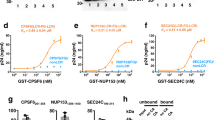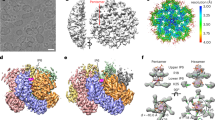Abstract
Formation of infectious HIV-1 involves assembly of Gag polyproteins into immature particles and subsequent assembly of mature capsids after proteolytic disassembly of the Gag shell. We report a 12-mer peptide, capsid assembly inhibitor (CAI), that binds the capsid (CA) domain of Gag and inhibits assembly of immature- and mature-like capsid particles in vitro. CAI was identified by phage display screening among a group of peptides with similar sequences that bind to a single reactive site in CA. Its binding site was mapped to CA residues 169–191, with an additional contribution from the last helix of CA. This result was confirmed by a separate X-ray structure analysis showing that CAI inserts into a conserved hydrophobic groove and alters the CA dimer interface. The CAI binding site is a new target for antiviral development, and CAI is the first known inhibitor directed against assembly of immature HIV-1.
This is a preview of subscription content, access via your institution
Access options
Subscribe to this journal
Receive 12 print issues and online access
$189.00 per year
only $15.75 per issue
Buy this article
- Purchase on Springer Link
- Instant access to full article PDF
Prices may be subject to local taxes which are calculated during checkout






Similar content being viewed by others
Accession codes
References
Briggs, J.A. et al. The stoichiometry of Gag protein in HIV-1. Nat. Struct. Mol. Biol. 11, 672–675 (2004).
Wiegers, K. et al. Sequential steps in human immunodeficiency virus particle maturation revealed by alterations of individual Gag polyprotein cleavage sites. J. Virol. 72, 2846–2854 (1998).
Lanman, J. et al. Key interactions in HIV-1 maturation identified by hydrogen-deuterium exchange. Nat. Struct. Mol. Biol. 11, 676–677 (2004).
Accola, M.A., Höglund, S. & Göttlinger, H.G. A putative alpha-helical structure which overlaps the capsid-p2 boundary in the human immunodeficiency virus type 1 Gag precursor is crucial for viral particle assembly. J. Virol. 72, 2072–2078 (1998).
Gitti, R.K. et al. Structure of the amino-terminal core domain of the HIV-1 capsid protein. Science 273, 231–235 (1996).
Gamble, T.R. et al. Structure of the carboxyl-terminal dimerization domain of the HIV-1 capsid protein. Science 278, 849–852 (1997).
Worthylake, D.K., Wang, H., Yoo, S., Sundquist, W.I. & Hill, C.P. Structures of the HIV-1 capsid protein dimerization domain at 2.6Å resolution. Acta Crystallogr. D Biol. Crystallogr. 55, 85–92 (1999).
Mortuza, G.B. et al. High-resolution structure of a retroviral capsid hexameric amino-terminal domain. Nature 431, 481–485 (2004).
Li, S., Hill, C., Sundquist, W. & Finch, J. Image reconstructions of helical assemblies of the HIV-1 CA protein. Nature 407, 409–413 (2000).
del Álamo, M., Neira, J.L. & Mateu, M.G. Thermodynamic dissection of a low affinity protein-protein interface involved in human immunodeficiency virus assembly. J. Biol. Chem. 278, 27923–27929 (2003).
Lanman, J. et al. Identification of novel interactions in HIV-1 capsid protein assembly by high-resolution mass spectrometry. J. Mol. Biol. 325, 759–772 (2003).
von Schwedler, U.K., Stray, K.M., Garrus, J.E. & Sundquist, W.I. Functional surfaces of the human immunodeficiency virus type 1 capsid protein. J. Virol. 77, 5439–5450 (2003).
Ganser-Pornillos, B.K., von Schwedler, U.K., Stray, K.M., Aiken, C. & Sundquist, W.I. Assembly properties of the human immunodeficiency virus type 1 CA protein. J. Virol. 78, 2545–2552 (2004).
Gross, I. et al. A conformational switch controlling HIV-1 morphogenesis. EMBO J. 19, 103–113 (2000).
Campbell, S. et al. Modulation of HIV-like particle assembly in vitro by inositol phosphates. Proc. Natl. Acad. Sci. USA 98, 10875–10879 (2001).
Ivanov, D., Stone, J.R., Maki, J.L., Collins, T. & Wagner, G. Mammalian SCAN domain dimer is a domain-swapped homolog of the HIV capsid C-terminal domain. Mol. Cell 17, 137–143 (2005).
Niedrig, M. et al. Inhibition of infectious human immunodeficiency virus type 1 particle formation by Gag protein-derived peptides. J. Gen. Virol. 75, 1469–1474 (1994).
Höglund, S. et al. Tripeptide interference with human immunodeficiency virus type 1 morphogenesis. Antimicrob. Agents Chemother. 46, 3597–3605 (2002).
Garzón, M.T. et al. The dimerization domain of the HIV-1 capsid protein binds a capsid protein-derived peptide: a biophysical characterization. Protein Sci. 13, 1512–1523 (2004).
Tang, C. et al. Antiviral inhibition of the HIV-1 capsid protein. J. Mol. Biol. 327, 1013–1020 (2003).
Li, F. et al. PA-457: a potent HIV inhibitor that disrupts core condensation by targeting a late step in Gag processing. Proc. Natl. Acad. Sci. USA 100, 13555–13560 (2003).
Zhou, J. et al. Small-molecule inhibition of human immunodeficiency virus type 1 replication by specific targeting of the final step of virion maturation. J. Virol. 78, 922–929 (2004).
Ternois, F., Sticht, J., Duquerroy, S., Kräusslich, H.-G. & Rey, A.F. Crystal structure of the HIV-1 capsid protein C-terminal domain in complex with an inhibitor of particle assembly. Nat. Struct. Mol. Biol. 12, 678–682 (2005).
Kräusslich, H.-G., Fäcke, M., Heuser, A.M., Konvalinka, J. & Zentgraf, H. The spacer peptide between human immunodeficiency virus capsid and nucleocapsid proteins is essential for ordered assembly and viral infectivity. J. Virol. 69, 3407–3419 (1995).
Gross, I., Hohenberg, H. & Kräusslich, H. In vitro assembly properties of purified bacterially expressed capsid proteins of human immunodeficiency virus. Eur. J. Biochem. 249, 592–600 (1997).
Briggs, J.A.G., Wilk, T., Welker, R., Kräusslich, H.-G. & Fuller, S.D. Structural organization of authentic, mature HIV-1 virions and cores. EMBO J. 22, 1707–1715 (2003).
Newman, J.L., Butcher, E.W., Patel, D.T., Mikhaylenko, Y. & Summers, M.F. Flexibility in the P2 domain of the HIV-1 Gag polyprotein. Protein Sci. 13, 2101–2107 (2004).
Lanman, J., Sexton, J., Sakalian, M. & Prevelige, P. Kinetic analysis of the role of intersubunit interactions in human immunodeficiency virus type 1 capsid protein assembly in vitro. J. Virol. 76, 6900–6908 (2002).
Mateu, M.G. Conformational stability of dimeric and monomeric forms of the C-terminal domain of human immunodeficiency virus-1 capsid protein. J. Mol. Biol. 318, 519–531 (2002).
Hyde-DeRuyscher, R. et al. Detection of small-molecule enzyme inhibitors with peptides isolated from phage-displayed combinatorial peptide libraries. Chem. Biol. 7, 17–25 (2000).
Kattenbeck, B., von Poblotzki, A., Rohrhofer, A., Wolf, H. & Modrow, S. Inhibition of human immunodeficiency virus type 1 particle formation by alterations of defined amino acids within the C terminus of the capsid protein. J. Gen. Virol. 78, 2489–2496 (1997).
Forshey, B.M., von Schwedler, U., Sundquist, W.I. & Aiken, C. Formation of a human immunodeficiency virus type 1 core of optimal stability is crucial for viral replication. J. Virol. 76, 5667–5677 (2002).
Liang, C., Hu, J., Whitney, J.B., Kleiman, L. & Wainberg, M.A. A structurally disordered region at the C terminus of capsid plays essential roles in multimerization and membrane binding of the gag protein of human immunodeficiency virus type 1. J. Virol. 77, 1772–1783 (2003).
Reicin, A.S. et al. Linker insertion mutations in the human immunodeficiency virus type 1 gag gene: effects on virion particle assembly, release, and infectivity. J. Virol. 69, 642–650 (1995).
von Schwedler, U.K. et al. Proteolytic refolding of the HIV-1 capsid protein amino-terminus facilitates viral core assembly. EMBO J. 17, 1555–1568 (1998).
Yoo, S. et al. Molecular recognition in the HIV-1 capsid/cyclophilin A complex. J. Mol. Biol. 269, 780–795 (1997).
Franke, E.K., Yuan, H.E. & Luban, J. Specific incorporation of cyclophilin A into HIV-1 virions. Nature 372, 359–362 (1994).
Adachi, A. et al. Production of acquired immunodeficiency syndrome-associated retrovirus in human and nonhuman cells transfected with an infectious molecular clone. J. Virol. 59, 284–291 (1986).
Ratner, L. et al. Complete nucleotide sequences of functional clones of the AIDS virus. AIDS Res. Hum. Retroviruses 3, 57–69 (1987).
Kay, L.E. Pulsed-field gradient multidimensional NMR methods for the study of protein structure and dynamics. Prog. Biophys. Mol. Biol. 63, 277–299 (1995).
Sattler, M., Schleucher, J. & Griesinger, C. Heteronuclear multidimensional NMR experiments for the structure determination of proteins in solution employing pulsed field gradients. Prog. Nucl. Magn. Reson. Spectrosc. 34, 93–158 (1999).
Delaglio, F. et al. NMRPipe: a multidimensional spectral processing system based on UNIX pipes. J. Biomol. NMR 6, 277–293 (1995).
Johnson, B.A. & Blevins, R.A. NMRView: a computer program for the visualization and analysis of NMR data. J. Biomol. NMR 4, 603–614 (1994).
Koradi, R., Billeter, M. & Wüthrich, K. MOLMOL: a program for display and analysis of macromolecular structure. J. Mol. Graph. 14, 51–55 (1996).
Acknowledgements
This work was supported in part by the Deutsche Forschungsgemeinschaft and the DAAD-PROCOPE program. J.W. and S.F. thank the Wellcome Trust for support of the NMR facility. We thank F. Rey for helpful discussions.
Author information
Authors and Affiliations
Corresponding author
Ethics declarations
Competing interests
The authors declare no competing financial interests.
Rights and permissions
About this article
Cite this article
Sticht, J., Humbert, M., Findlow, S. et al. A peptide inhibitor of HIV-1 assembly in vitro. Nat Struct Mol Biol 12, 671–677 (2005). https://doi.org/10.1038/nsmb964
Received:
Accepted:
Published:
Issue Date:
DOI: https://doi.org/10.1038/nsmb964
This article is cited by
-
Unprotected peptide macrocyclization and stapling via a fluorine-thiol displacement reaction
Nature Communications (2022)
-
Rotten to the core: antivirals targeting the HIV-1 capsid core
Retrovirology (2021)
-
Multiple Roles of HIV-1 Capsid during the Virus Replication Cycle
Virologica Sinica (2019)
-
Structure and mutagenesis reveal essential capsid protein interactions for KSHV replication
Nature (2018)
-
MxB binds to the HIV-1 core and prevents the uncoating process of HIV-1
Retrovirology (2014)



